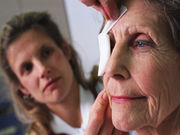Two cases from same vehicle described, with both patients presenting with bilateral corneal edema
MONDAY, April 25, 2016 (HealthDay News) — In a report published online April 15 in Clinical and Experimental Ophthalmology, two cases are presented of alkali eye injuries secondary to airbag deployment.
Angela Richards, M.B.B.S., from the Royal Brisbane and Women’s Hospital Herston in Australia, documents two cases of alkali eye injuries secondary to airbag deployment from the same vehicle.
According to Richards, two patients were hospitalized following a motor vehicle collision: a 67-year-old female with significant orthopedic injuries and her 65-year-old husband (the driver) with less severe orthopedic injuries and complaints of bilateral red, watery, uncomfortable eyes and blurred vision. The male patient was diagnosed with bilateral severe corneal edema and corneal abrasions of unknown etiology, while the female patient was referred to ophthalmology with a necrotic right eye. Both patients had similar findings, presenting with bilateral corneal edema and subtotal right corneal epithelial defects, large right nasal conjunctival epithelial defects, and small left epithelial defects. Over seven weeks, the driver’s epithelial defects healed with topical preservative-free lubricants. Both patients developed trichiasis requiring repeated epilation in order to allow corneal epithelial defects to heal.
“It is our responsibility to mitigate sequelae such as corneal scarring and cicatricial disease and educate our emergency physician colleagues to ensure early, copious irrigation is performed if indicated,” Richards writes. “Extensive medical resources and ocular morbidity in these cases may have been avoided if early irrigation had been initiated.”
Full Text (subscription or payment may be required)
Copyright © 2016 HealthDay. All rights reserved.








